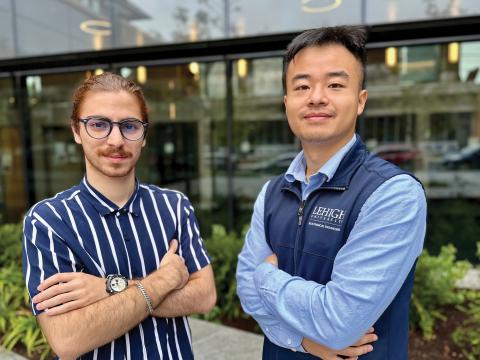Story by Rachel Curry
Image by Rob Gerth
Here are three real-world examples.
Now more than ever, an employee’s tenure at any given job may be only a few years. Because of this trend, companies aren’t as invested in on-the-job training. “Businesses want people ready to get moving,” says Patrick Zoro, Lehigh Business Master’s in Financial Engineering (MFE) program manager and teaching assistant professor of finance.
Fortunately for MFE students, their master’s projects are perfect opportunities to learn by doing, show creativity, and partner with corporate entities—giving their projects real-world implications.
From Undergrad Thesis to Master’s Creation
Second-semester MFE student Edris Lotfpouri is bridging the gap between his background in computer engineering and goal of working in the financial services industry. Lotfpouri is currently developing a groundbreaking computer platform that aims to provide a benchmark for cryptocurrency price prediction models. The idea started as an undergraduate thesis and evolved into a tangible project.
Crypto prices are innately volatile, making accurate price prediction difficult. Lotfpouri says his standardized benchmarking system could facilitate collaboration, increasing innovation in the space. Having partnered with a crypto research firm in the past, Lotfpouri plans to evolve his live demo into a public version that makes a tangible difference in the crypto realm.
Diversification That Goes Deeper
Asim Turk returned to school in the MFE program after graduating college and spending time in the workforce. He wanted to go deeper into the math behind the finance, and his project on multi-factor investing demonstrates how his aspiration is coming to fruition.
In the stock market, Turk says, “Diversifying by sectors means little if those sectors share the same underlying risk factors.” In partnership with his corporate sponsor, an asset manager in Philadelphia, Turk is creating an optimization model to start or rebalance a portfolio based on an investor’s choice of exposure to different underlying risk factors.
“This project can become the foundation of a strategy an asset management company can use,” says Turk.
Solving the ‘Black Box’ Problem
First-year MFE student Sisheng Liang knows there must be a level of trust in machine learning outputs if asset managers are going to use them. But the presence of “black box” machine learning models, or models that provide outputs with no explanation of how they reached the conclusion, complicates this trust. That’s why Liang’s project on the interpretability of machine learning outputs is important.
People must trust the machine, but how? Liang says, “We want to give people a reason to trust the machine.” In partnership with the author of a book on machine learning, Liang plans to develop a website where users can upload their data and the website will generate various interpretations of how the decision or prediction was reached—ultimately demystifying black box machine learning models.
Beyond the Drawing Board
“These students are working with corporate entities, and they’re learning things they would not learn through the curriculum, essentially getting two curricula—theoretically and practically based,” Zoro says. “Ultimately, these MFE projects go well past ideation; they help students leap into their career and innovate.”


